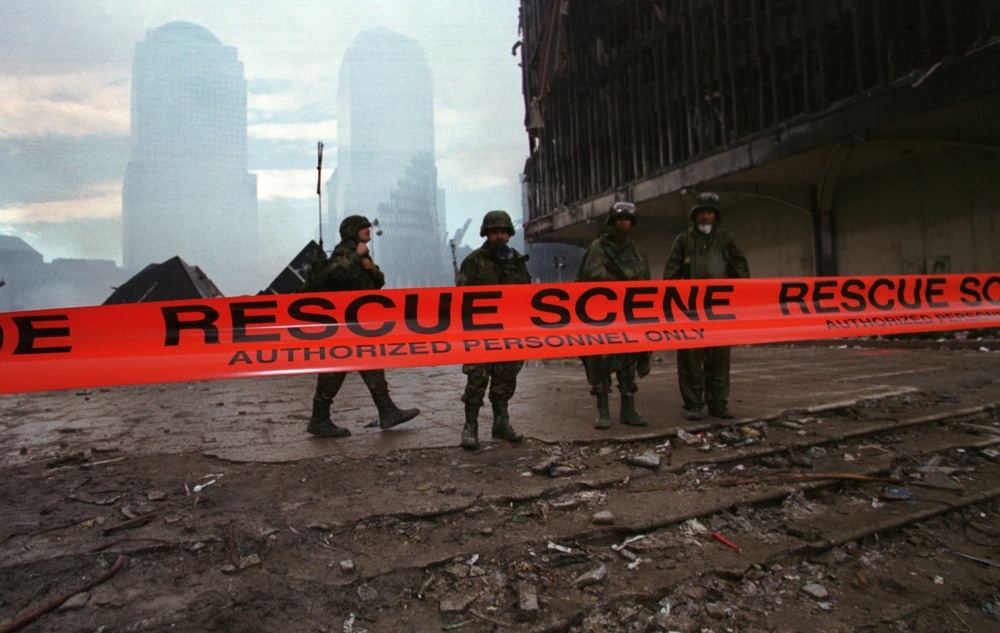


September 11: Escaping the South Tower and a Framework of Surviving an Infrastructure Disaster
Detect, Deny, Deduce, Debate, Decide, Do, Drive, Deliver and Divulge
Kevin Laub was in the South Tower of the World Trade Center on 9/11 when the North Tower was struck by the first plane. Despite being told there was nothing to worry about, followed by instructions to stay in-place and the inertia and paralysis of his fellow co-workers, Kevin’s military, survival and innate understanding of human behavior gave him the tools to quickly assess the situation and flee the building.
Recently, Kevin spoke to mid-career professionals within several U.S. intelligence agencies and military services who are taking a graduate course in Infrastructure Vulnerability Assessment at the National Intelligence University (NIU). The course is part of NIU’s master’s degree in Science and Technology Intelligence.
We live in dangerous times. We all need to be prepared to respond to dangerous situations at a moment’s notice. Kevin’s story below is instructive and utterly gripping. We urge you to take a few minutes and read it through to the end. You’ll be glad you did.
——————————————–
Written for Homeland Security Today by Dr. Mitchell E. Simmons, Lieutenant Colonel, United States Air Force (Retired), Associate Dean for Academic Affairs and Program Director in the Anthony G. Oettinger School of Science and Technology Intelligence at the National Intelligence University in Bethesda, Maryland.
Kevin Laub, a former employee of a financial services firm, and now a high school English teacher for almost 20-plus years in Northern Virginia, sits in his home virtually sharing his experience of escaping the South Tower of the World Trade complex on September 11, 2001. However, he’s not talking to a classroom of high school students, but rather mid-career professionals within several U.S. intelligence agencies and military services who are taking a graduate course in Infrastructure Vulnerability Assessment at the National Intelligence University (NIU). The course is part of NIU’s master’s degree in Science and Technology Intelligence but is also available to students through NIU’s Homeland Security Intelligence certificate program.
Two years after September 11, 2001, then student-teacher Kevin Laub spoke to a class of juniors regarding his experience. These students had been high school freshman on that horrific day and were old enough to have understood what was occurring and many had parents who worked at the Pentagon. As he described his experience many of them openly cried because they too had experienced that day, and it impacted them. Over the years, the average age of Kevin’s students became younger and younger, and the last academic year of any student alive on that day was in 2019, according to his student roster. Despite that, on or about each September 11 anniversary, Kevin shares his firsthand account of escaping the South Tower to classrooms of students.
For several years now, Kevin has also been speaking to NIU students. The course instructor, the author of this article, uses Kevin’s experience to illustrate a key aspect of infrastructure vulnerability, which are the people that utilize it, work within it, and maintain it, and who must survive it when things go bad. The author of this article uses Kevin’s experience to greatly expand on a framework of survival discussed by Amanda Ripley in her 2008 book titled “The Unthinkable: Who Survives When Disasters Strikes – and Why.”[1] She speaks of a “survival arc” of denial, deliberation, and decision. However, the author’s military, survival, human behavior, and infrastructure training and expertise expanded this “survival arc” to a more comprehensive nine-step survival bridge comprised of Detect, Deny, Deduce, Debate, Decide, Do, Drive, Deliver, and Divulge. In essence, the survival bridge connects the side of danger and death to the side of safety and life, but this bridge covers a great chasm of dangers trying to stop those from saving themselves consisting of non-beneficial human behavior, poor training, poor decision making, poor messaging, poor luck, poor timing, uncertainty, confusion, chaos, fog, and countless other circumstances and factors. The following is Kevin’s experience, in the context of this nine-step survival bridge.
To read the rest, click here.
Photo Credit: Master Sgt. Mark Olsen/177th Fighter Wing – NJ Air National Guard